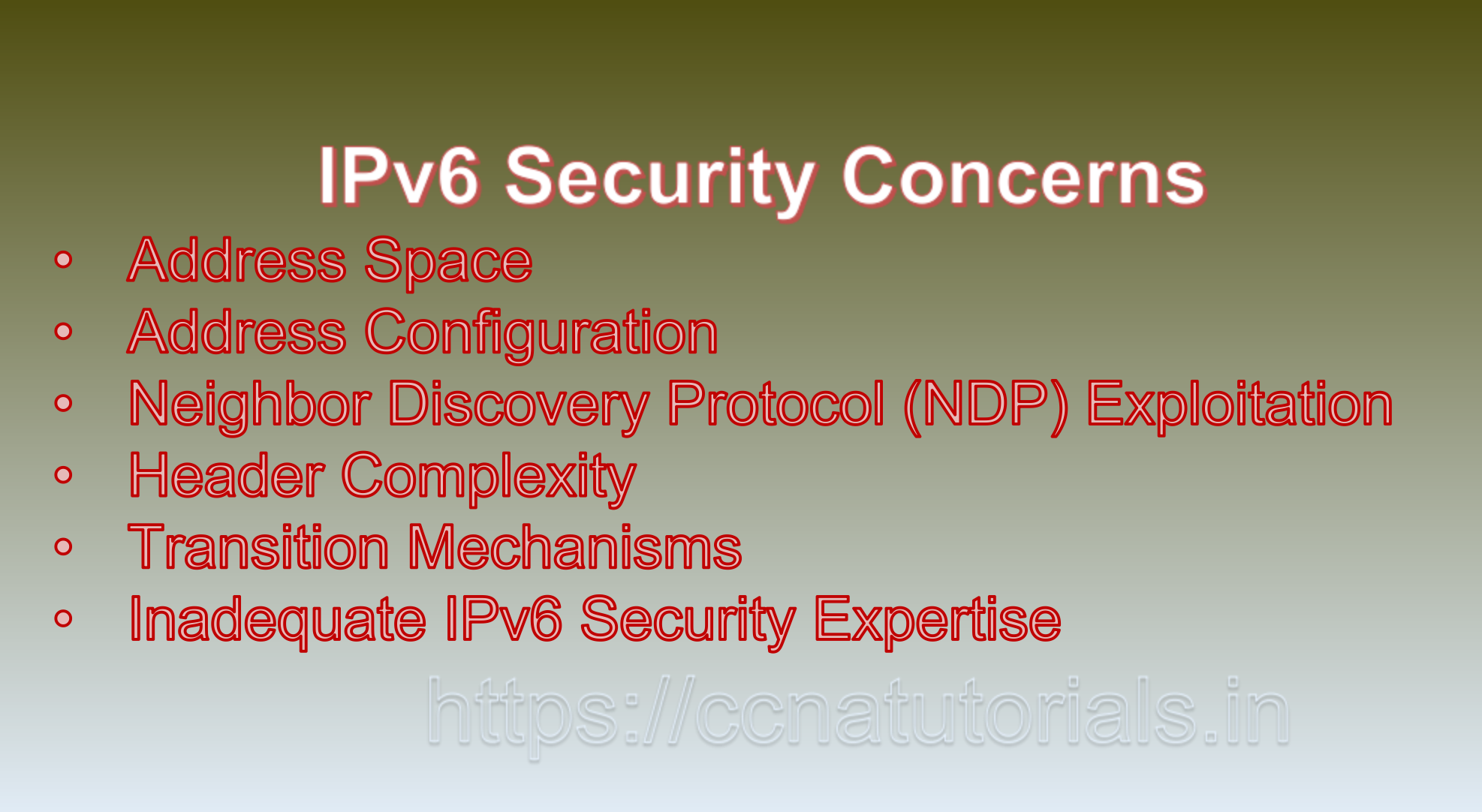Contents of this article
In this article, I describe IPv6 Security Considerations: Ensuring Robust Network Protection IPv6, the successor to IPv4, introduces numerous enhancements to networking, including a larger address space and improved functionalities. However, with these advancements come new security challenges that network administrators must address to ensure the safety and integrity of their systems. This article delves into IPv6 security considerations, highlighting potential vulnerabilities and providing examples of how these concerns can impact network security.
IPv6 Security Concerns:
1. Address Space:
IPv6’s vast address space poses a challenge for security practitioners. While this enables greater device connectivity, it also complicates address scanning and reconnaissance. Attackers can have a harder time finding targets due to the sheer size of the IPv6 address pool. However, it doesn’t eliminate the need for proper security measures.
2. Address Configuration:
IPv6 supports multiple address configuration methods, such as stateless autoconfiguration and DHCPv6. If not properly managed, these methods could lead to unauthorized devices obtaining valid addresses and gaining access to the network.
3. Neighbor Discovery Protocol (NDP) Exploitation:
IPv6’s Neighbor Discovery Protocol (NDP) plays a crucial role in address resolution and neighbor discovery. However, it can be exploited for attacks like Neighbor Advertisement Spoofing, where malicious nodes falsely claim to be legitimate routers.
4. Header Complexity:
IPv6 headers are more complex than those of IPv4, providing various options and extension headers. While this complexity offers flexibility, it also increases the attack surface for potential vulnerabilities.
5. Transition Mechanisms:
During the transition from IPv4 to IPv6, mechanisms like Dual-Stack and tunneling can introduce security gaps if not properly configured. For instance, attackers could exploit tunnels to bypass security controls.
6. Inadequate IPv6 Security Expertise:
Network administrators may lack experience with IPv6 security, leading to misconfigurations and weak protection measures.
Examples of IPv6 Security Concerns:
1. Address Scanning and Reconnaissance:
– In IPv6, the sheer number of possible addresses can make traditional address scanning techniques less effective. However, attackers can still conduct targeted attacks using tools like “THC-IPv6” to identify hosts.
– Example: An attacker could use an IPv6 scanner to identify active hosts within a target’s network, collecting information for further exploitation.
2. Rogue Router Advertisements:
– Attackers can send rogue Router Advertisement (RA) messages to trick hosts into using their malicious router. This could lead to man-in-the-middle attacks.
– Example: An attacker sends deceptive RA messages to hosts, directing their traffic through the attacker’s machine, allowing them to intercept and manipulate data.
3. Fragmentation-based Attacks:
– IPv6’s support for fragmentation can be exploited for packet reassembly attacks, causing system crashes or resource exhaustion.
– Example: An attacker sends maliciously crafted fragmented packets to a target system, exploiting vulnerabilities in the reassembly process and causing a denial-of-service (DoS) condition.
4. Privacy Considerations:
– IPv6 autoconfiguration can result in devices generating temporary addresses to protect their privacy. However, these addresses can still be used for tracking.
– Example: An online service may track users by correlating their temporary IPv6 addresses over time, potentially compromising user privacy.
5. Misconfigured Transition Mechanisms:
– Improperly configured transition mechanisms like 6to4 or Teredo can expose internal networks to external threats by creating direct connectivity to the IPv6 Internet.
– Example: A misconfigured 6to4 tunnel allows unauthorized external access to an organization’s internal resources, bypassing security controls.

Mitigating IPv6 Security Concerns:
1. Network Design and Configuration:
– Implement proper network segmentation, firewalls, and intrusion detection systems.
– Carefully configure IPv6 address assignment methods to prevent unauthorized devices from joining the network.
2. NDP Security:
– Employ mechanisms like Secure Neighbor Discovery (SEND) to authenticate NDP messages.
– Monitor network traffic for abnormal NDP behavior that may indicate attacks.
3. Firewall Rules and Filtering:
– Apply stringent firewall rules, filtering traffic at both the network and application layers.
– Filter traffic containing certain types of IPv6 extension headers that may be indicative of attacks.
4. Security Training:
– Provide training to network administrators and security personnel to ensure a strong understanding of IPv6 security principles.
In short IPv6 Security Considerations:
IPv6 brings substantial improvements to networking but also introduces new security considerations that organizations must address. The complexity of IPv6 headers, the potential for address scanning, rogue router advertisements, and fragmentation-based attacks underscore the importance of robust security measures. Through proper network design, configuration, monitoring, and training, organizations can navigate the challenges presented by IPv6 and build secure, resilient networks that harness the benefits of the protocol while safeguarding against potential vulnerabilities.
IPv6 Security Considerations: Enhancing Network Protection in the New Internet Era
As the world transitions to IPv6, the latest iteration of the Internet Protocol, a range of new security considerations arise. While IPv6 offers numerous improvements over its predecessor IPv4, it also presents unique challenges and potential vulnerabilities that network administrators and security professionals must address. This article delves into key IPv6 security considerations, exploring the potential risks and providing insights into strategies for enhancing network protection.
1. Larger Address Space:
One of the most touted advantages of IPv6 is its significantly larger address space, which supports the ever-expanding number of devices connecting to the Internet. However, this expanded space can also make network scanning and reconnaissance more challenging for administrators. While IPv4 allowed attackers to easily scan large address ranges, IPv6 requires more sophisticated techniques due to its immense address pool.
Example:
In IPv4, a simple network scanner can quickly discover active hosts within a given IP range. In contrast, in IPv6, attackers would need to expend significantly more effort to scan even a small fraction of the available address space.
2. Stateless Address Autoconfiguration (SLAAC):
IPv6 introduces Stateless Address Autoconfiguration (SLAAC), enabling devices to automatically configure their IPv6 addresses without the need for a central server. While convenient, SLAAC can potentially be exploited by malicious actors to perform unauthorized device impersonation, leading to unauthorized access to networks.
Example:
An attacker can exploit SLAAC by setting up a rogue device with a legitimate-looking IPv6 address. This rogue device can then intercept network traffic, leading to potential data breaches or man-in-the-middle attacks.
3. Neighbor Discovery Protocol (NDP):
NDP, a core component of IPv6, serves various functions including address resolution and neighbor discovery. However, attackers can abuse NDP for reconnaissance and attacks like Neighbor Solicitation (NS) flooding, where excessive NS messages saturate network resources.
Example:
An attacker might launch an NS flooding attack, causing network congestion and potentially degrading the overall network performance.
4. IPsec Integration:
IPv6 includes IPsec (Internet Protocol Security) as a mandatory feature, enhancing security at the IP layer by providing authentication, encryption, and integrity protection. However, IPsec is not always fully implemented or enabled in IPv6 networks, leaving potential security gaps.
Example:
If IPsec is not properly configured or enforced, sensitive data transmitted over the network might be vulnerable to interception or tampering by malicious actors.
5. Transition Mechanisms:
During the transition from IPv4 to IPv6, various mechanisms are employed to ensure compatibility. These mechanisms, such as Dual Stack, Tunneling, and Translation, can introduce vulnerabilities if not properly configured, leading to potential security breaches.
Example:
Attackers might exploit misconfigured IPv6 tunneling to bypass network security controls or perform attacks that target IPv4 systems through IPv6 tunnels.
6. Privacy Extensions:
IPv6 introduced Privacy Extensions to mitigate concerns about device tracking based on the predictable structure of IPv6 addresses. However, if these extensions are not enabled, devices may be susceptible to tracking and profiling.
Example:
Without Privacy Extensions, a device’s IPv6 address remains static over time, potentially allowing advertisers or malicious entities to track the device’s online activities.
7. Fragmentation and Reassembly:
IPv6 reduces the need for fragmentation by requiring end systems to perform fragmentation and reassembly. However, attackers can exploit fragmentation vulnerabilities, leading to resource exhaustion attacks.
Example:
An attacker might send a series of fragmented packets that, when reassembled, cause a target device to consume excessive memory or processing resources, leading to a denial-of-service (DoS) condition.
Mitigation Strategies:
To enhance the security of IPv6 networks, administrators can implement several best practices:
1. IPv6 Network Audits:
Regularly audit your network to identify rogue devices, unauthorized configurations, and potential vulnerabilities.
2. Proper Configuration:
Ensure that IPv6 routers, firewalls, and devices are properly configured to prevent unauthorized access and attacks.
3. IPsec Implementation:
Implement and enforce IPsec to secure communication and data integrity.
4. Network Monitoring:
Employ network monitoring tools to detect and respond to abnormal traffic patterns or signs of potential attacks.
5. Access Control and Authentication:
Enforce access control policies and use strong authentication mechanisms to prevent unauthorized access.
6. Network Segmentation:
Segment your network to contain potential breaches and limit the lateral movement of attackers.
7. Intrusion Detection and Prevention Systems:
Deploy intrusion detection and prevention systems to detect and block malicious activities.
Conclusion for IPv6 Security Considerations::
While IPv6 offers numerous benefits, including a larger address space and improved security features like mandatory IPsec, it also introduces new security considerations that demand vigilance from network administrators and security professionals. By understanding the potential risks, implementing best practices, and continuously monitoring and adapting their security strategies, organizations can navigate the transition to IPv6 with confidence, ensuring a secure and resilient network infrastructure in the new Internet era.






